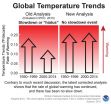Evidence against a global warming hiatus?
2015-06-04
(Press-News.org) This news release is available in Japanese.
An analysis using updated global surface temperature data disputes the existence of a 21st century global warming slowdown described in studies including the latest Intergovernmental Panel on Climate Change (IPCC) assessment. The new analysis suggests no discernable decrease in the rate of warming between the second half of the 20th century, a period marked by manmade warming, and the first fifteen years of the 21st century, a period dubbed a global warming "hiatus." Numerous studies have been done to explain the possible causes of the apparent hiatus. Here, Karl and colleagues focused on aspects of the hiatus influenced by biases from temperature observation networks, which are always changing. Using updated and corrected temperature observations taken at thousands of weather observing stations over land and as many commercial ships and buoys at sea, the researchers show that temperatures in the 21st century did not plateau, as thought. Instead, the rate of warming during the first fifteen years of the 21st century is at least as great as that in the last half of the 20th century, suggesting warming is continuing apace. According to these and other results, the authors suggest the warming slowdown was an illusion, an artifact of earlier analyses.
INFORMATION:
Article #16: "Possible artifacts of data biases in the recent global surface warming hiatus," by T.R. Karl; A. Arguez; B. Huang; J.H. Lawrimore; M.J. Menne; T.C. Peterson; R.S. Vose; H.-M. Zhang at National Oceanographic and Atmospheric Administration (NOAA) in Asheville, NC; J.R. McMahon at LMI in McLean, VA.
[Attachments] See images for this press release:


ELSE PRESS RELEASES FROM THIS DATE:
2015-06-04
This news release is available in Japanese.
Many species are migrating toward Earth's poles in response to climate change, and their habitats are shrinking in the process, researchers say. Two new reports focusing on marine organisms, which have been moving pole-ward at higher rates than terrestrial creatures, show how factors, including those not directly related to climate change, are limiting the ranges of corals and fish. Paul Muir and colleagues investigated 104 species of reef corals -- collectively known as the staghorn corals -- and confirmed the hypothesis ...
2015-06-04
This news release is available in Japanese. With less than a drop of blood, a new technology called VirScan can identify all of the viruses that individuals have been exposed to over the course of their lives. Researchers used the screening technique with 569 people from around the world and found that, on average, their participants had been exposed to about 10 viral species over their lifetimes. VirScan provides a powerful and inexpensive tool for studying interactions between the human virome -- the collection of viruses known to infect humans, some of which don't ...
2015-06-04
This news release is available in Japanese. Some of the world's last isolated tribes are emerging from the Amazon rainforest, forcing scientists and policymakers in South America to reconsider their policies regarding contact with such people. In this special package of news, Science correspondents Andrew Lawler and Heather Pringle report from Peru and Brazil, respectively -- two countries that are dealing with a spate of first encounters. Lawler describes contact between isolated tribespeople emerging from the forest and indigenous Peruvian villagers, who themselves ...
2015-06-04
New technology developed by Howard Hughes Medical Institute (HHMI) researchers makes it possible to test for current and past infections with any known human virus by analyzing a single drop of a person's blood. The method, called VirScan, is an efficient alternative to existing diagnostics that test for specific viruses one at a time.
With VirScan, scientists can run a single test to determine which viruses have infected an individual, rather than limiting their analysis to particular viruses. That unbiased approach could uncover unexpected factors affecting individual ...
2015-06-04
Friction is all around us, working against the motion of tires on pavement, the scrawl of a pen across paper, and even the flow of proteins through the bloodstream. Whenever two surfaces come in contact, there is friction, except in very special cases where friction essentially vanishes -- a phenomenon, known as "superlubricity," in which surfaces simply slide over each other without resistance.
Now physicists at MIT have developed an experimental technique to simulate friction at the nanoscale. Using their technique, the researchers are able to directly observe individual ...
2015-06-04
A revolutionary power shift from internet giants such as Google to ordinary consumers is critically overdue, according to new research from a University of East Anglia (UEA) online privacy expert.
In a manifesto that ranges from "the right to be treated fairly on the internet" to finding a better, more nuanced approach to using the internet as an archive, Dr Paul Bernal of UEA's School of Law delves deeper into his research on the so-called 'right to be forgotten.' His paper, called 'A right to be remembered? Or the internet, warts and all,' will be presented today at ...
2015-06-04
The red, itchy rash caused by varicella-zoster - the virus that causes chickenpox - usually disappears within a week or two. But once infection occurs, the varicella-zoster virus, or VZV, remains dormant in the nervous system, awaiting a signal that causes this "sleeper" virus to be re-activated in the form of an extremely unpleasant but common disease: herpes zoster, or shingles.
In a study recently published in PLOS Pathogens, scientists at Bar-Ilan University report on a novel experimental model that, for the first time, successfully mimics the "sleeping" and "waking" ...
2015-06-04
Washington, DC-Unreliable estrogen measurements have had a negative impact on the treatment of and research into many hormone-related cancers and chronic conditions. To improve patient care, a panel of medical experts has called for accurate, standardized estrogen testing methods in a statement published in the Endocrine Society's Journal of Clinical Endocrinology & Metabolism (JCEM).
The panel's recommendations are the first to address how improved testing methods can affect clinical care, and were developed based on discussions at an estrogen measurement workshop hosted ...
2015-06-04
Women who exercise during pregnancy are less likely to have gestational diabetes, and the exercise also helps to reduce maternal weight gain, finds a study published on 3 June 2015 in BJOG: an International Journal of Obstetrics and Gynaecology.
Gestational diabetes is one of the most frequent complications of pregnancy. It is associated with an increased risk of serious disorders such as pre-eclampsia, hypertension, preterm birth, and with induced or caesarean birth. It can have long term effects on the mother including long term impaired glucose tolerance and type ...
2015-06-04
CAMBRIDGE, Mass. (June 4, 2015) - Leveraging a novel system designed to examine the double-strand DNA breaks that occur as a consequence of gene amplification during DNA replication, Whitehead Institute scientists are bringing new clarity to the causes of such genomic damage. Moreover, because errors arising during DNA replication and gene amplification result in chromosomal abnormalities often found in malignant cells, these new findings may bolster our understandings of certain drivers of cancer progression.
At the core of system, developed in the lab of Whitehead ...
LAST 30 PRESS RELEASES:
[Press-News.org] Evidence against a global warming hiatus?


